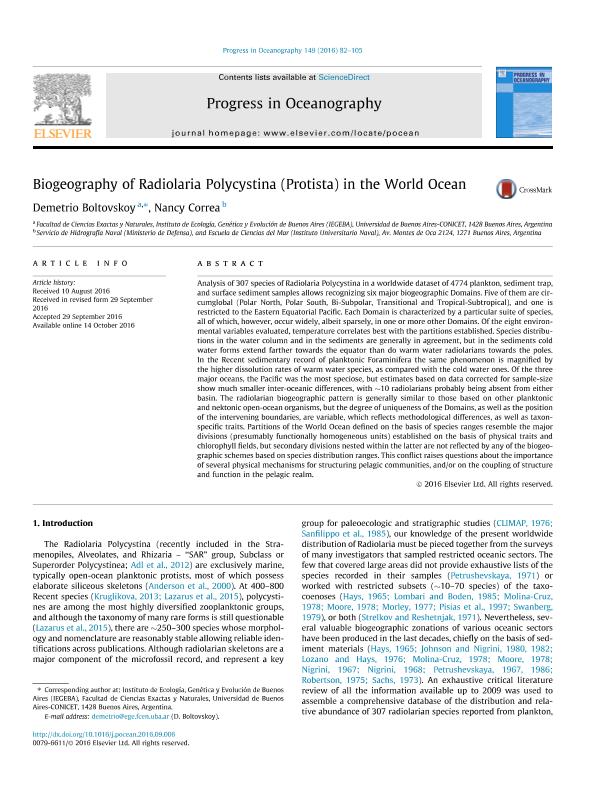Mostrar el registro sencillo del ítem
dc.contributor.author
Boltovskoy, Demetrio

dc.contributor.author
Correa, Nancy Myriam

dc.date.available
2018-10-01T17:54:55Z
dc.date.issued
2016-12
dc.identifier.citation
Boltovskoy, Demetrio; Correa, Nancy Myriam; Biogeography of Radiolaria Polycystina (Protista) in the World Ocean; Pergamon-Elsevier Science Ltd; Progress In Oceanography; 149; 12-2016; 82-105
dc.identifier.issn
0079-6611
dc.identifier.uri
http://hdl.handle.net/11336/61390
dc.description.abstract
Analysis of 307 species of Radiolaria Polycystina in a worldwide dataset of 4774 plankton, sediment trap, and surface sediment samples allows recognizing six major biogeographic Domains. Five of them are circumglobal (Polar North, Polar South, Bi-Subpolar, Transitional and Tropical-Subtropical), and one is restricted to the Eastern Equatorial Pacific. Each Domain is characterized by a particular suite of species, all of which, however, occur widely, albeit sparsely, in one or more other Domains. Of the eight environmental variables evaluated, temperature correlates best with the partitions established. Species distributions in the water column and in the sediments are generally in agreement, but in the sediments cold water forms extend farther towards the equator than do warm water radiolarians towards the poles. In the Recent sedimentary record of planktonic Foraminifera the same phenomenon is magnified by the higher dissolution rates of warm water species, as compared with the cold water ones. Of the three major oceans, the Pacific was the most speciose, but estimates based on data corrected for sample-size show much smaller inter-oceanic differences, with ∼10 radiolarians probably being absent from either basin. The radiolarian biogeographic pattern is generally similar to those based on other planktonic and nektonic open-ocean organisms, but the degree of uniqueness of the Domains, as well as the position of the intervening boundaries, are variable, which reflects methodological differences, as well as taxon-specific traits. Partitions of the World Ocean defined on the basis of species ranges resemble the major divisions (presumably functionally homogeneous units) established on the basis of physical traits and chlorophyll fields, but secondary divisions nested within the latter are not reflected by any of the biogeographic schemes based on species distribution ranges. This conflict raises questions about the importance of several physical mechanisms for structuring pelagic communities, and/or on the coupling of structure and function in the pelagic realm.
dc.format
application/pdf
dc.language.iso
eng
dc.publisher
Pergamon-Elsevier Science Ltd

dc.rights
info:eu-repo/semantics/openAccess
dc.rights.uri
https://creativecommons.org/licenses/by-nc-nd/2.5/ar/
dc.subject
Radiolaria
dc.subject
Polycystina
dc.subject
Biogeography
dc.subject
World Ocean
dc.subject.classification
Otras Ciencias Biológicas

dc.subject.classification
Ciencias Biológicas

dc.subject.classification
CIENCIAS NATURALES Y EXACTAS

dc.title
Biogeography of Radiolaria Polycystina (Protista) in the World Ocean
dc.type
info:eu-repo/semantics/article
dc.type
info:ar-repo/semantics/artículo
dc.type
info:eu-repo/semantics/publishedVersion
dc.date.updated
2018-10-01T16:09:21Z
dc.journal.volume
149
dc.journal.pagination
82-105
dc.journal.pais
Estados Unidos

dc.description.fil
Fil: Boltovskoy, Demetrio. Consejo Nacional de Investigaciones Científicas y Técnicas. Oficina de Coordinación Administrativa Ciudad Universitaria. Instituto de Ecología, Genética y Evolución de Buenos Aires. Universidad de Buenos Aires. Facultad de Ciencias Exactas y Naturales. Instituto de Ecología, Genética y Evolución de Buenos Aires; Argentina
dc.description.fil
Fil: Correa, Nancy Myriam. Ministerio de Defensa. Armada Argentina. Servicio de Hidrografía Naval; Argentina
dc.journal.title
Progress In Oceanography

dc.relation.alternativeid
info:eu-repo/semantics/altIdentifier/doi/http://dx.doi.org/10.1016/j.pocean.2016.09.006
dc.relation.alternativeid
info:eu-repo/semantics/altIdentifier/url/https://www.sciencedirect.com/science/article/pii/S0079661116301501
Archivos asociados
